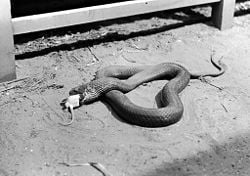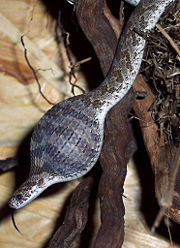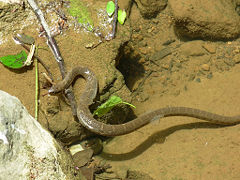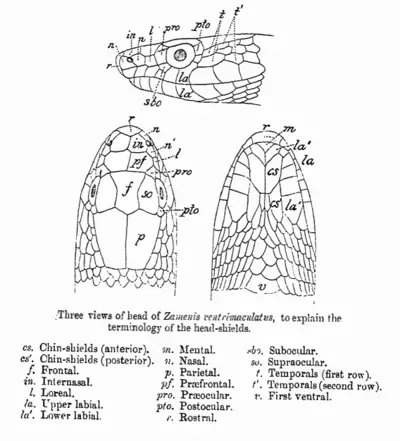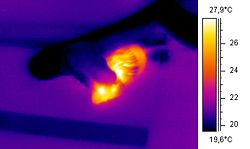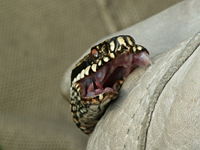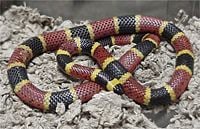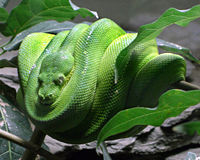Snake
| Snakes
| ||||||||||||||||||
|---|---|---|---|---|---|---|---|---|---|---|---|---|---|---|---|---|---|---|
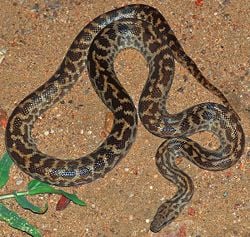 Spotted Python
Antaresia maculosa | ||||||||||||||||||
| Scientific classification | ||||||||||||||||||
| ||||||||||||||||||
|
Snake is any of the numerous elongate, limbless, scaled, carnivorous reptiles comprising the suborder Serpentes (or Ophidia) of the order Squamata. Snakes generally are distinguished from lizardsâwhich also belong to order Squamata, but are placed in suborder Sauria (or Lacertilia)â by the absence of legs, although some lizards are legless. Snakes are also differentiated from lizards by have more flexible jaws and by lacking external ear openings and movable eyelids whereas most lizards (but not all) have movable eyelids and external ear openings.
The more than 2,900 species of snakes are spread across every continent except Antarctica. They range in size from the tiny thread snake to pythons and anacondas over 10 meters long.
Of the twenty biological families of snakes, three are known to be venomous (Elapidae, Viperidae, Atractaspididae) with some venomous members found in a fourth family (Colubridae), although there are indications venomous snakes may be more common than previously thought (Fry et al. 2006). Although the majority of venomous snakes are small innocuous creatures, many are capable of causing painful injury or death to humans. Venom in snakes is more for killing and subduing prey than it is for self-defense.
Although snakes in some cultures tend to have an unfavorable reputation, the reality is that they offer important ecological, economic, and symbolic values. Ecologically, they help to maintain the balance of nature, and are important in controlling pest rodents and insects that can damage agricultural crops, infest homes, and serve as vectors of disease. They have served as food and provided snake skin for commercial products. They have also served as symbols throughout history. They have been revered in some historical cultures, such as Ancient Egypt, and even in some present societies, such as India, which is steeped in tradition regarding snakes (Deane 1833). Three important medical symbols involving snakes are used today: the Bowl of Hygieia, symbolizing pharmacy, and the Caduceus and Rod of Asclepius, which are symbols denoting medicine in general (Wilcox and Whitham 2003).
A literary word for snake is serpent. In modern usage, the term serpent usually refers to a mythic or symbolic snake. In Christianity, the serpent is often identified with the devil, as in the Biblical account of Adam and Eve. Serpent is a Middle English word that comes from Old French, and ultimately from *serp-, "to creep" (Merriam-Webster).
Overview and basic description
The order Squamata is composed of snakes (suborder Serpentes) and lizards (suborder Squamata). Members of this reptilian order are distinguished by having a lower jaw that is not joined directly to the skull, scales, and the presence of paired reproductive organs in the male (Towle 1989).
Snakes have more flexible jaws than lizards, lack movable eyelids, lack external ear openings, and generally lack limbs entirely, although some species have traces of hind limbs. Lizards usually have movable eyelids (although see geckos), external ear openings (although see chameleons), and most have four-well developed limbs, often with five toes on each foot. Some lizard species, including the glass lizard and legless lizards, lack functional legs although there are some vestigial structures. These are distinguished from true snakes by the presence of eyelids and ears and a tail that can sometimes break off as a physical defense mechanism.
In order to accommodate snakes' narrow bodies, paired organs (such as kidneys) appear one in front of the other instead of side by side. A snake has only one lung functional for breathing.
Snakes may have evolved from a lizard that adapted to burrowing during the Cretaceous period (around 150 million years ago). The diversity of modern snakes appeared during the Paleocene period (around 66 to 56 million years ago).
There are over 2,900 species of snakes ranging as far northward as the Arctic Circle in Scandinavia and southward through Australia and Tasmania (Sanchez 2007). Snakes can be found on every continent with the exception of Antarctica, dwelling in the sea and as high as 16,000 feet (4900m) in the Himalayan Mountains of Asia (Sanchez 2007; Conant and Collins 1991, 143). There are numerous islands from which snakes are conspicuously absent such as Ireland, Iceland, and New Zealand (Conant and Collins 1991, p. 143).
Digestion and diet
All snakes are strictly carnivorous, eating animals such as lizards, other snakes, small mammals, birds, eggs, fish, snails and insects (Mehrtens 1987; Sanchez 2007; Behler and King 1979; Kaplan 1996).
Some snakes have a venomous bite, which they use to kill their prey before eating it (Freiberg 1984; Behler and King 1979). Some snakes kill their prey by constriction (Bebler 1979). Still others swallow their prey whole and alive (Behler and King 1979; Mehrtens 1987). Pareas iwesakii and other snail-eating Colubrids of subfamily Pareatinae have more teeth on the right side of their mouths than on the left, as the shells of their prey usually spiral clockwise (Hoso et al. 2007; Mehrtens 1987).
Snakes do not chew their food and have a very flexible lower jawâthe two halves of which are not rigidly attachedâand numerous other joints in their skull allowing them to open their mouths wide enough to swallow their prey whole, even if it is larger in diameter than the snake itself (Behler and King 1979). The African egg-eating snake has flexible jaws adapted for eating eggs much larger than the diameter of its head (Mehrtens 1987). This snake has no teeth, but does have bony protrusions on the inside edge of its spine that aid in breaking the shells of the eggs it eats (Mehrtens 1987).
After eating, snakes become torpid while the process of digestion takes place (Rosenfeld 1989). Digestion is an intense activity, especially after the consumption of very large prey. In species that feed only sporadically, the entire intestine enters a reduced state between meals to conserve energy, and the digestive system is "up-regulated" to full capacity within 48 hours of prey consumption. Being ectothermic or cold blooded, the surrounding temperature plays a large role in a snakes digestion. The ideal temperature for snakes to digest their food is around 30 degrees Celsius. So much metabolic energy is involved in digestion that in Crotalus durissus, the Mexican rattlesnake, an increase of body temperature to as much as 14 degrees Celsius above the surrounding environment has been observed (Tattersall et al. 2004). Because of this, a snake disturbed after having eaten recently will often regurgitate its prey in order to be able to escape the perceived threat. However, when undisturbed, the digestive process is highly efficient, dissolving and absorbing everything but hair and claws, which are excreted along with uric acid waste. Snakes have been known to die from trying to swallow an animal that is too big.
Skin
The skin of a snake is covered in scales. Scales protect the body of the snake, aid it in locomotion, allow moisture to be retained within, alter the surface characteristics such as roughness to aid in camouflage, and in some cases even aid in prey capture (such as Acrochordus). Scales have been modified over time to serve other functions such as "eyelash" fringes, and protective covers for the eyes, with the most distinctive modification being the rattle of the North American rattlesnakes.
The body scales may be smooth, keeled, or granular. Snake's eyelids are transparent, "spectacle" scales that remain permanently closed, also known as brille. Most snakes use specialized belly scales to travel, gripping surfaces. Contrary to the popular notion of snakes being slimy (perhaps because of possible confusion of snakes with worms), snakeskin has a smooth, dry texture.
The shedding of scales is called ecdysis, or, in normal usage molting or sloughing. In the case of snakes, the complete outer layer of skin is shed in one layer (Smith 1973). Snake scales are not discrete but extensions of the epidermis; hence, they are not shed separately, but are ejected as a complete contiguous outer layer of skin during each molt.
Molting serves a number of functions. First, the old and worn skin is replaced. Second, molting helps to get rid of parasites, such as mites and ticks. Renewal of the skin by molting allows growth in some animals, such as insects, and is believed to also serve this function in snakes, although this view is disputed.
Moulting is repeated periodically throughout a snake's life. Before a molt, the snake stops eating and often hides or moves to a safe place. Just prior to shedding, the skin becomes dull and dry looking and the eyes become cloudy or blue-colored. The inner surface of the old outer skin liquefies. This causes the old outer skin to separate from the new inner skin. After a few days, the eyes clear and the snake "crawls" out of its old skin. The old skin breaks near the mouth and the snake wriggles out aided by rubbing against rough surfaces. In many cases, the cast skin peels backward over the body from head to tail, in one piece like an old sock. A new, larger, and brighter layer of skin has formed underneath (SDGFP 2007).
An older snake may shed its skin only once or twice a year, but a younger, still-growing snake, may shed up to four times a year (SDGFP 2007). The discarded skin gives a perfect imprint of the scale pattern and it is usually possible to identify the snake if this discard is reasonably complete and intact. This periodic renewal has led to the snake being a symbol of healing and medicine, as pictured in the Rod of Asclepius (Wilcox and Whitham 2003).
The shape and number of scales on the head, back, and belly are characteristic to family, genus, and species. Scales have a nomenclature analogous to the position on the body. In "advanced" (Caenophidian) snakes, the broad belly scales and rows of dorsal scales correspond to the vertebrae, allowing scientists to count the vertebrae without dissection.
Scalation counts are also used to tell the sex of a snake when the species is not readily sexually dimorphic. A probe is inserted into the cloaca until it can go no further. The probe is marked at the point where it stops, removed, and compared to the subcaudal depth by laying it alongside the scales (Rosenfeld 1989). The scalation count determines whether the snake is a male or female as hemipenes of a male will probe to a different depth (usually shorter) than the cloaca of a female (Rosenfeld 1989).
Internal organs
The vestigial left lung in snakes is often small or sometimes even absent, as snakes' tubular bodies require all of their organs to be long and thin (Mader 1996). In the majority of species, only one lung is functional. This lung contains a vascularized anterior portion and a posterior portion that does not function in gas exchange (Mader 1996). This posterior "saccular lung" is used for hydrostatic purposes to adjust buoyancy in some aquatic snakes and its function remains unknown in terrestrial species (Mader 1996).
Many organs that are paired, such as kidneys or reproductive organs, are staggered within the body, with one located ahead of the other (Mader 1996). Snakes have no colenary bladder or lymph nodes (Mader 1996).
As with all reptiles, snakes have a three-chambered heart composed of two atria and one large ventricle (Mader 1996). Although more evolutionarily basic than the mammalian four-chambered heart, it functions in a similar manner because of divisions and valves within the ventricle (Mader 1996). The cardiovascular system of snakes is also unique due to the presence of a renal portal system in which the blood from the snake's tail passes through the kidneys before returning to the heart (Mader 1996).
Locomotion
Snakes use various methods to move on land or in water (Cogger and Zweifel 1992).
Lateral undulation is the sole mode of aquatic locomotion, and the most common mode of terrestrial locomotion (Cogger and Zweifel 1992). In this mode, the body of the snake alternately flexes to the left and right, resulting in a series of rearward-moving "waves" (Cogger and Zweifel 1992). When swimming, the waves become larger as they move down the snake's body, and the wave travels backwards faster than the snake moves forwards (Cogger and Zweifel 1992). This contrasts with terrestrial lateral undulation, in which the wave speed is precisely the same as the snake speed, and as a result, every point on the snake's body follows the path of the point ahead of it, allowing snakes to move though very dense vegetation and small openings (Cogger and Zweifel 1992). In aquatic lateral undulation, snakes generate forward thrust by pushing their body against the water, resulting in the observed slip, while in terrestrial lateral undulation, thrust is generated by pushing against irregularities in the substrate such as pebbles and grass, resulting in "path following" (Cogger and Zweifel 1992). In spite of overall similarities, studies show that the pattern of muscle activation is substantially different in aquatic versus terrestrial lateral undulation, which justifies calling them separate modes. All snakes can laterally undulate forwards (with backward-moving waves), but only sea snakes have been observed reversing the pattern, in other words, moving backwards via forward-traveling waves.
When the snake must move in an environment that lacks any irregularities to push against, such as a slick mud flat or sand dune, colubroid snakes (colubrids, elapids, and vipers) usually employ sidewinding (Cogger and Zweifel 1992). Most common in short, stocky snakes, sidewinding is a modified form of lateral undulation in which all of the body segments oriented in one direction remain in contact with the ground, while the other segments are lifted up, resulting in a peculiar "rolling" motion (Cogger and Zweifel 1992). Contrary to some sources, there is no evidence that sidewinding is associated with hot sand (Cogger and Zweifel 1992). Boas and pythons have never been observed sidewinding.
Both sidewinding and lateral undulation require substantial space, but some environments, such as tunnels, have very limited space and in these instances snakes rely on concertina locomotion (Cogger and Zweifel 1992). In this mode, the snake braces the posterior portion of its body against the tunnel wall while the front of the snake extends and straightens (Cogger and Zweifel 1992). The front portion then flexes and forms an anchor point, and the posterior is straightened and pulled forwards (Cogger and Zweifel 1992).
The slowest mode of snake locomotion is rectilinear locomotion, which is also the only one in which the snake does not bend its body laterally (Cogger and Zweifel 1992). In this mode, the belly scales are lifted and pulled forward before being placed down and the body pulled over them. Waves of movement and stasis pass posteriorly, resulting in a series of ripples in the skin (Cogger and Zweifel 1992). In spite of appearances, the ribs do not move in this mode of locomotion and this method is most often used by large pythons, boas, and pit vipers when creeping up to prey across open ground as the snakes movements are subtle and harder to detect in this manner (Cogger and Zweifel 1992).
The movement of snakes in arboreal habitats has only recently been studied (Cogger and Zweifel 1992). Gliding snakes (Chrysopelea) of Southeast Asia launch themselves from branch tips, spread their ribs, and laterally undulate as they glide between trees; these snakes are even capable of executing sharp turns in mid-air (Cogger and Zweifel 1992; Freiberg 1984). While on the branches, snakes use several modes of locomotion depending on species and bark texture (Cogger and Zweifel 1992).
Perception
While snake vision is unremarkable (generally being best in arboreal species and worst in burrowing species), it is able to detect movement (Cogger and Zweifel 1992). Some snakes, like the Asian vine snake (genus Ahaetulla), have binocular vision. In most snakes, the lens moves back and forth within the eyeball to focus; snakes focus by moving the lens in relation to the retina. In addition to their eyes, some snakes (pit vipers, pythons, and some boas) have infrared-sensitive receptors in deep grooves between the nostril and eye, although some have labial pits on their upper lip just below the nostrils(common in pythons) which allow them to "see" the radiated heat (Cogger and Zweifel 1992).
A snake smells by using its forked tongue to collect airborne particles then passing them to the Jacobson's organ or the Vomeronasal organ in the mouth for examination (Cogger and Zweifel 1992). The fork in the tongue gives the snake a sort of directional sense of smell and taste simultaneously (Cogger and Zweifel 1992). The snake keeps its tongue constantly in motion, sampling particles from the air, ground, and water analyzing the chemicals found and determining the presence of prey or predators in its local environment (Cogger and Zweifel 1992).
The part of the body which is in direct contact with the surface of the ground is very sensitive to vibration, thus a snake is able to sense other animals approaching through detecting faint vibrations in the air and on the ground (Cogger and Zweifel 1992).
Reproduction
Although a wide range of reproductive modes are used by snakes; all snakes employ internal fertilization, accomplished by means of paired, forked hemipenes, which are stored inverted in the male's tail (Capula et al. 1989). The hemipenes are often grooved, hooked, or spined in order to grip the walls of the female's cloaca (Capula et al. 1989).
Three reproductive modes are known in snakes: egg-laying, ovoviviparous, and viviparous.
Egg-laying. Most species of snake lay eggs, and most of those species abandon them shortly after laying; however, individual species such as the king cobra actually construct nests and stay in the vicinity of the hatchlings after incubation (Capula et al. 1989). Most pythons coil around their egg-clutches after they have laid them and remain with the eggs until they hatch (Capula et al. 1989). The female python will not leave the eggs, except to occasionally bask in the sun or drink water and will generate heat to incubate the eggs by shivering (Capula et al. 1989).
Ovoviviparous. Some species of snake are ovoviviparous and retain the eggs within their bodies until they are almost ready to hatch (Capula et al. 1989; Cogger and Zweifel 1992). Unlike the embryos of viviparous species, ovoviviparous embryos are nourished by the egg yolk rather than by the mother's body.
Viviparous. Recently, it has been confirmed that several species of snake are fully viviparous, such as the boa constrictor and green anaconda, nourishing their young through a placenta as well as a yolk sac, which is highly unusual among reptiles, or anything else outside of placental mammals (Capula et al. 1989; Cogger and Zweifel 1992). Retention of eggs and live birth are most often associated with colder environments (Capula et al. 1989; Cogger and Zweifel 1992).
Venom
A venomous snake is a snake that uses modified saliva known as venom, delivered through fangs in its mouth, to immobilize or kill its prey (Mehrtens 1987, 243). The fangs of "advanced" venomous snakes like vipers and elapids are hollow in order to inject venom more effectively, while the fangs of rear-fanged snakes such as the Boomslang merely have a groove on the posterior edge to channel venom into the wound. Snake venoms are often prey specific, its role in self-defense is secondary (Mehrtens 1987, 243).
Venom, like all salivary secretions, is a pre-digestant that initiates the breakdown of food into soluble compounds allowing for proper digestion, and even "non-venomous" snake bites (like any animal bite) will cause tissue damage (Mehrtens 1987, 209). Certain birds, mammals, and other snakes such as kingsnakes that prey on venomous snakes, have developed resistance and even immunity to certain venom (Mehrtens 1987, 243).
Venomous snakes are found in diverse families of snakes and do not constitute a formal classification group used in taxonomy. The term poisonous snake is mostly incorrectâpoison is inhaled or ingested whereas venom is injected (Freiberg 1984, 125). There are, however, two examples of poisonous snakes are known to exist. Rhabdophis sequesters toxins from the toads it eats then secretes them from nuchal glands to ward off predators, and a small population of garter snakes in Oregon retains enough toxin in their liver from the newts they eat to be effectively poisonous to local small predators such as crows and foxes (Freiberg 1984, 123).
Snake venoms are complex mixtures of proteins and are stored in poison glands at the back of the head (Freiberg 1984, 123). In all venomous snakes, these glands open through ducts into grooved or hollow teeth in the upper jaw (Mehrtens 1987, 243; Freiberg 1984, 5). These proteins can potentially be a mix of neurotoxins (which attack the nervous system), hemotoxins (which attack the circulatory system), cytotoxins, bungarotoxins, and many other toxins that affect the body in different ways (Frieberg 1984, 125). Almost all snake venom contains hyaluronidase, an enzyme that ensures rapid diffusion of the venom (Mehrtens 1987, 243).
Venomous snakes that use hemotoxins usually have the fangs that secrete the venom in the front of their mouths, making it easier for them to inject the venom into their victims (Frieberg 1984, 125). Some snakes that use neurotoxins, such as the mangrove snake, have their fangs located in the back of their mouths, with the fangs curled backwards. This makes it both difficult for the snake to use its venom and for scientists to milk them (Frieberg 1984, 125). Elapid snakes, however, such as cobras and kraits, are proteroglyphous, possessing hollow fangs that cannot be erected toward the front of their mouths and cannot "stab" like a viper; they must actually bite the victim (Mehrtens 1987, 242).
It has recently been suggested that all snakes may be venomous to a certain degree (Fry et al. 2006). Snakes may have evolved from a common lizard ancestor that was venomous, from which venomous lizards like the gila monster and beaded lizard may have also derived. This hypothesis suggests that all snakes have venom glands, even species thought totally harmless such as the corn snake, commonly kept as a pet. What differentiates "venomous" from "non-venomous" is the evolution of a venom delivery system, the most advanced being that of vipers, with fangs that are hinged to prevent self envenomation, curling out only when the snake strikes.
Venomous snakes are largely classified in two taxonomic families:
- Elapids - cobras including king cobras, kraits, mambas, Australian copperheads, sea snakes, and coral snakes.
- Viperids - vipers, rattlesnakes, copperheads/cottonmouths, adders and bushmasters.
The family Atractaspididae (burrowing asps, mole vipers, etc.) also is comprised of venomous snakes, although this taxon has been moved into and out of the family level and is not universally recognized. There is a fourth family, Colubridae (colubrids), containing the opistoglyphous (rear-fanged) snakes as well as the majority of other snake species (Freiberg 1984; 126; Mehrtens 1987, 209), such as boomslangs, tree snakes, vine snakes, mangrove snakes. Not all colubrids are venomous.
Taxonomy
Snakes are categorized in the order Squamata within the entire suborder Serpentes. There are two infraorders of Serpentes: Alethinophidia and Scolecophidia. This separation is based primarily on morphological characteristics between family groups and mitochondrial DNA.
As with most taxonomic classifications, there are different interpretations of the evolutionary relationships. These include moving of families to different infraorders, merging or splitting of the infraorders, and merging and splitting of the families. For instance, many sources classify Boidae and Pythonidae as the same family, or keep others, such as Elapidae and Hydrophiidae, separate for practical reasons despite their extremely close relation.
| colspan="100%" align="center" bgcolor="#BBBBFF" | Alethinophidia 15 families | ||
| Family | Common Names | Example Species | Example Photo |
|---|---|---|---|
| Acrochordidae Bonaparte, 1831 |
file snakes | Marine File Snake (Acrochordus granulatus) | 
|
| Aniliidae Stejneger, 1907 |
coral pipe snakes | Burrowing False Coral (Anilius scytale) | |
| Anomochilidae Cundall, Wallach and Rossman, 1993 |
dwarf pipe snakes | Leonard's Pipe Snake, (Anomochilus leonardi) | |
| Atractaspididae Günther, 1858 |
mole vipers | Stiletto Snake (Atractaspis bibroni) | |
| Boidae Gray, 1825 |
boas | Amazon tree boa (Corallus hortulanus) | 
|
| Bolyeridae Hoffstetter, 1946 |
round island boas | Round Island Burrowing Boa (Bolyeria multocarinata) | |
| Colubridae Oppel, 1811 |
colubrids | Grass Snake (Natrix natrix) | 
|
| Cylindrophiidae Fitzinger, 1843 |
Asian pipe snakes | Red-tailed Pipe Snake (Cylindrophis ruffus) | |
| Elapidae Boie, 1827 |
cobras, coral snakes, mambas, kraits, sea snakes, sea kraits, Australian elapids | King Cobra (Ophiophagus hannah) | 
|
| Loxocemidae Cope, 1861 |
Mexican burrowing snakes | Mexican burrowing snake (Loxocemus bicolor) | 
|
| Pythonidae Fitzinger, 1826 |
pythons | Ball python (Python regius) | 
|
| Tropidophiidae Brongersma, 1951 |
dwarf boas | Northern Eyelash Boa (Trachyboa boulengeri) | |
| Uropeltidae Müller, 1832 |
shield-tailed snakes, short-tailed snakes | Ocellated Shield-tail (Uropeltis ocellatus) | |
| Viperidae Oppel, 1811 |
vipers, pitvipers, rattlesnakes | European asp (Vipera aspis) | |
| Xenopeltidae Bonaparte, 1845 |
sunbeam snakes | Sunbeam snake (Xenopeltis unicolor) | |
| colspan="100%" align="center" bgcolor="#BBBBFF" | Scolecophidia 3 families | ||
| Family | Common Names | Example Species | Example Photo |
| Anomalepidae Taylor, 1939 |
dawn blind snakes | Dawn Blind Snake (Liotyphlops beui) | |
| Leptotyphlopidae Stejneger, 1892 |
slender blind snakes | Texas Blind Snake (Leptotyphlops dulcis) | 
|
| Typhlopidae Merrem, 1820 |
blind snakes | Black Blind Snake (Typhlops reticulatus) |
Evolution
Phylogeny of snakes is poorly known because snake skeletons are typically small and fragile, making fossilization uncommon. However 150 million year old specimens readily definable as snakes, with lizard-like skeletal structures, have been uncovered in South America and Africa (Mehrtens 1987, 11). It has been agreed, on the basis of morphology, that snakes descended from lizard-like ancestors (Sanchez 2007; Mehrtens 1987, 11).
Fossil evidence suggests that snakes may have evolved from burrowing lizards, such as varanids or a similar group during the Cretaceous period (McDowell 1972). An early fossil snake, Najash rionegrina, was a two-legged burrowing animal with a sacrum, and was fully terrestrial (Apesteguia and Zaher 2006). One extant analog of these putative ancestors is the earless monitor Lanthanotus of Borneo, although it also is semi-aquatic (Mertens 1961). As these ancestors became more subterranean, it is speculated that they lost their limbs and their bodies became more streamlined for burrowing (Mertens 1961). According to this hypothesis, features such as the transparent, fused eyelids (brille) and loss of external ears evolved to combat subterranean conditions, such as scratched corneas and dirt in the ears, with snakes reemerging onto the surface of the earth much as they are today (Mertens 1961; McDowell 1972)
Other primitive snakes are known to have possessed hindlimbs but lacked a direct connection of the pelvic bones to the vertebrae, including Haasiophis, Pachyrhachis and Eupodophis) which are slightly older than Najash (AAAS 2000). Primitive groups among the modern snakes, pythons and boas, have vestigial hind limbs: tiny, clawed digits known as anal spurs, which are used to grasp during mating (AAAS 2000; Mehrtens 1987, 11). Leptotyphlopidae and Typhlopidae are other examples where remnants of the pelvic girdle are still present, sometimes appearing as horny projections when visible. The frontal limbs in all snakes are non-existent because of the evolution of the Hox genes in this area.
The axial skeleton of the snakes' common ancestor had, like most other tetrapods, the familiar regional specializations consisting of cervical (neck), thoracic (chest), lumbar (lower back), sacral (pelvic) and caudal (tail) vertebrae. The Hox gene expression in the axial skeleton responsible for the development of the thorax became dominant early in snake evolution and as a result, the vertebrae anterior to the hindlimb buds (when present) all have the same thoracic-like identity (except from the atlas, axis and 1-3 neck vertebrae), making most of the snake's skeleton being composed of an extremely extended thorax. Ribs are found exclusively on the thoracic vertebrae. The neck, lumbar, and pelvic vertebrae are very reduced in number (only 2-10 lumbar and pelvic vertebrae are still present), while only a short tail remains of the caudal vertebrae, although the tail is still long enough to be of good use in many species, and is modified in some aquatic and tree dwelling species.
An alternative hypothesis, based on morphology, suggests that the ancestors of snakes were related to mosasaursâextinct aquatic reptiles from the Cretaceousâwhich in turn are thought to have derived from varanid lizards (Sanchez 2007). Under this hypothesis, the fused, transparent eyelids of snakes are thought to have evolved to combat marine conditions (corneal water loss through osmosis), while the external ears were lost through disuse in an aquatic environment, ultimately leading to an animal similar in appearance to sea snakes of today. It is held that in the Late Cretaceous, snakes re-colonized the land much like they are today. Fossil snake remains are known from early Late Cretaceous marine sediments, which is consistent with this hypothesis, particularly as they are older than the terrestrial Najash rionegrina. Similar skull structure, reduced/absent limbs, and other anatomical features found in both mosasaurs and snakes lead to a positive cladistical correlation, although some of these features are shared with varanids. In recent years, genetic studies have indicated that snakes are not as closely related to monitor lizards as it was once believed, and therefore not to mosasaurs, the proposed ancestor in the aquatic scenario of their evolution. However, there is more evidence linking mosasaurs to snakes than to varanids. Fragmentary remains that have been found from the Jurassic and Early Cretaceous indicate deeper fossil records for these groups, which may eventually refute either hypothesis.
The great diversity of modern snakes appeared in the Paleocene, correlating with the adaptive radiation of mammals following the extinction of the dinosaurs.
Interactions with humans
Snake bite
Snakes do not ordinarily prey on humans and most will not attack humans unless the snake is startled or injured, preferring instead to avoid contact. With the exception of large constrictors, non-venomous snakes are not a threat to humans. The bites of non-venomous snakes are usually harmless because their teeth are designed for grabbing and holding, rather than tearing or inflicting a deep puncture wound. Although the possibility of an infection and tissue damage is present in the bite of a non-venomous snake; venomous snakes present far greater hazard to humans (Mehrtens 1987, 209).
Documented deaths resulting from snake bites are uncommon. Non-fatal bites from venomous snakes may result in the need for amputation of a limb or part thereof. Of the roughly 725 species of venomous snakes worldwide, only 250 species are known as able to kill a human with one bite. Although Australia is home to the largest number of venomous snakes in the world, about one snakebite proves venomous, on average, in a year; in India where 250,000 snakebites are recorded in a single year, as many as 50,000 initial deaths are recorded (Sinha 2006).
The treatment for snakebite is quite variable. The most common and effective method is through antivenin, a serum made from the venom of the snake itself. Some antivenom is species specific (monovalent) and some is made for use with multiple species in mind (polyvalent). In the United States, for example, all species of venomous snakes are pit vipers, with the exception of the coral snake. To produce antivenin, a mixture of the venoms of the different species of rattlesnakes, copperheads, and cottonmouths is injected into the body of a horse in ever-increasing dosages until the horse is immunized. Blood is then extracted from the immunized horse and freeze-dried. It is reconstituted with sterile water and becomes antivenin. For this reason, people who are allergic to horses cannot be treated using anivenin. Antivenin for the more dangerous species (such as mambas, taipans, and cobras) is made in a similar manner in India, South Africa, and Australia with the exception being that those antivenins are species-specific.
Snake charmers
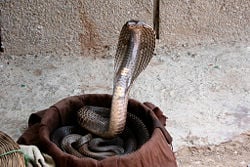
In some parts of the world, especially in India and Pakistan, snake charming is a roadside show performed by a charmer. In this, the snake charmer carries a basket that contains a snake which he seemingly charms by playing tunes from his flute-like musical instrument, to which the snake responds (Bagla 2002). Snakes lack external ears and snakes show no tendency to be influenced by music (Bagla 2002).
Researchers have pointed out that many of these snake charmers are good sleight-of-hand artists. The snake moves corresponding to the flute movement and the vibrations from the tapping of the charmer's foot, which is not noticed by the public. They rarely catch their snakes and the snakes typically are either nonvenomous or defanged cobras. Sometimes these people exploit the fear of snakes by releasing snakes into the neighborhood and then offering to rid the residence of snakes. Other snake charmers also have a snake and mongoose show, where both the animals have a mock fight; however, this is not very common, as the snakes, as well as the mongooses, may be seriously injured or killed.
Snake charming as a profession is now discouraged in India as a contribution to forest and snake conservation. In fact, in some places in India snake charming is banned by law (Bagla 2002).
Snake trapping
The tribal people of "Irulas" from Andhra Pradesh and Tamil Nadu in India have been hunter-gatherers in the hot dry plains forests and have practiced this art for generations. They have a vast knowledge of snakes in the field. Irulas generally catch the snakes with the help of a simple stick. Earlier, the Irulas caught thousands of snakes for the snake-skin industry. After the complete ban on snake-skin industry in India and protection of all snakes under the Indian Wildlife (Protection) Act 1972, they formed the Irula Snake Catcher's Cooperative and switched to catching snakes for removal of venom, releasing them in the wild after four extractions. The venom so collected is used for producing life-saving antivenin, biomedical research and for other medicinal products (Whitaker and Captain 2004). The Irulas are also known to eat some of the snakes they catch and snakes are very useful in rat extermination in the villages.
Modern day snake trapping typically involves a herpetologist using a long stick with a "V" shaped end. Some prefer to catch them using bare hands.
Consumption of snakes
In some cultures, the consumption of snakes is acceptable, or even considered a delicacy, and sometimes prized for its alleged pharmaceutical effects. Western cultures document the consumption of snakes under extreme circumstances of hunger (Irving 1954). Cooked rattlesnake meat is an exception, which is commonly consumed in the Western United States and referred to as "prairie chicken." In Asian countries such as Thailand,Indonesia, and Cambodia, drinking the blood of snakes, particularly the cobra, is believed to increase sexual virility (Flynn 2002). The blood is drained while the cobra is still alive when possible, and is usually mixed with some form of liquor to improve the taste (Flynn 2002).
In some Asian countries, the use of snakes in alcohol is also accepted. In such cases, the body of a snake or several snakes is left to steep in a jar or container of liquor. It is claimed that this makes the liquor stronger (as well as more expensive). One example of this is the Habu snake sometimes placed in the Okinawan liquor Awamori also known as "Habu Sake" (Allen 2001).
Symbolism


In Egyptian history, the snake occupies a primary role with the Nile cobra adorning the crown of the pharaoh in ancient times. It was worshiped as one of the gods and was also used for sinister purposes: murder of an adversary and ritual suicide (Cleopatra).
In Greek mythology, snakes are often associated with deadly and dangerous antagonists, but this is not to say that snakes are symbolic of evil; in fact, snakes are a cthonic symbol, (from the Greek khthonios) relating to the earth or the Underworld, roughly translated as "earthbound." The nine-headed Lernaean Hydra that Hercules defeated and the three Gorgon sisters are children of Gaia, the earth (Bullfinch 2000, 85). Medusa was one of the three Gorgon sisters who Perseus defeated (Bullfinch 2000). Medusa is described as a hideous mortal, with snakes instead of hair and the power to turn men to stone with her gaze (Bullfinch 2000). After killing her, Perseus gave her head to Athena who fixed it to her shield called the Aegis (Bullfinch 2000). The Titans are also depicted in art with snakes instead of legs and feet for the same reasonâthey are children of Gaia and Ouranos (Uranus), so they are bound to the earth.
Three medical symbols involving snakes that are still used today are Bowl of Hygieia, symbolizing pharmacy, and the Caduceus and Rod of Asclepius, which are symbols denoting medicine in general (Wilcox and Whitham 2003).
India is often called the land of snakes and is steeped in tradition regarding snakes (Deane 1833). Snakes are worshipped as gods even today with many women pouring milk on snake pits (despite snakes' aversion for milk) (Deane 1833, 61). The cobra is seen on the neck of Shiva and Vishnu is depicted often as sleeping on a 7 headed snake or within the coils of a serpent (Deane 1833, 62-64). There are also several temples in India solely for cobras sometimes called Nagraj (King of Snakes) and it is believed that snakes are symbols of fertility. There is a Hindu festival called Nag Panchami each year on which day snakes are venerated.
In Islam, Christianity, and Judaism, the snake makes its infamous appearance in the first book (Genesis 3:1) of the Bible when a serpent appears before the first couple Adam and Eve as an agent of the devil and tempts them with the forbidden fruit from the Tree of Life. The snake returns in Exodus when Moses, as a sign of God's power, turns his staff into a snake; snakes are similarly produced by the pharaoh's magic-practicing priests, but Moses's snake devours them. Later Moses made Nehushtan, a bronze snake on a pole, which when looked at cured the people of bites from the snakes that plagued them in the desert. In the Gospel of John (3:14), an analogy is made between this and Jesus Christ, in His quality of being the Redeemer: And as Moses lifted up the serpent in the wilderness, even so must the Son of man be lifted up." Elsewhere Jesus Christ instructed his disciples to be as shrewd as snakes and as innocent as doves (Matthew 10:16). The serpent makes its final appearance symbolizing Satan in the Book of Revelation: "And he laid hold on the dragon the old serpent, which is the devil and Satan, and bound him for a thousand years" (Revelation 20:2).
The Ouroboros is a symbol that is associated with many different religions and customs, and is also claimed to be related to alchemy. The Ouroboros or Oroboros is a snake eating its own tail in a clock-wise direction (from the head to the tail) in the shape of a circle, representing manifestation of one's own life and rebirth, leading to immortality.
The snake is one of the 12 celestial animals of Chinese Zodiac, in the Chinese calendar.
Many ancient Peruvian cultures worshipped nature (Benson 1972). They placed emphasis on animals and often depicted snakes in their art (Berrin and Larco Museum 1997).
ReferencesISBN links support NWE through referral fees
- Allen, D. 2001. Okinawaâs potent habu sake packs healthy punch, poisonous snake. Stars and Stripes July 22, 2001. Retrieved December 13, 2007.
- American Association For The Advancement Of Science (AAAS). 2000. New fossil snake with legs, reported in science Washington, D.C.. Wildlife News. Retrieved December 13, 2007.
- ApesteguÃa, S., and Hussam Zaher. 2006. A Cretaceous terrestrial snake with robust hindlimbs and a sacrum. Nature 440(7087): 1037-1040. Retrieved December 13, 2007.
- Bagla, P. 2002. India's snake charmers fade, blaming eco-Laws, TV. National Geographic News. Retrieved December 13, 2007.
- Behler, J. L. and F. W. King. 1979. The Audubon Society Field Guide to Reptiles and Amphibians of North America. New York: Alfred A. Knopf. ISBN 0394508246.
- Benson, Elizabeth 1972. The Mochica: A Culture of Peru. New York, NY: Praeger Press. ASIN: B000FLDSV2
- Berrin, K., and Larco Museum. 1997. The Spirit of Ancient Peru: Treasures from the Museo Arqueológico Rafael Larco Herrera. New York: Thames and Hudson. ISBN 0500018022.
- Bullfinch, T. 2000. Bullfinch's Complete Mythology. London: Chancellor Press. ISBN 0753703815. Retrieved December 13, 2007.
- Capula, M., G. Mazza, and J. L. Behler. 1989. Simon & Schuster's Guide to Reptiles and Amphibians of the World. Nature guide series. New York: Simon & Schuster. ISBN 0671690981.
- Coborn, J. 1991. The Atlas of Snakes of the World. New Jersey: TFH Publications. ISBN 9780866227490.
- Cogger, H., and R. Zweifel. 1992. Reptiles & Amphibians. Sydney, Australia: Weldon Owen. ISBN 0831727861.
- Conant, R., and J. Collins. 1991. A Field Guide to Reptiles and Amphibians Eastern/Central North America. Boston, MA: Houghton Mifflin Company. ISBN 0395583896.
- Deane, J. 1833. The Worship of the Serpent. Whitefish, MT: Kessinger Publishing. ISBN 1564598985.
- Ditmars, R. L. 1906. Poisonous Snakes of the United States: How to Distinguish Them. New York: E. R. Sanborn.
- Ditmars, R. L. 1931. Snakes of the World. New York: Macmillan.
- Ditmars, R. L. 1933. Reptiles of the World: The Crocodilians, Lizards, Snakes, Turtles and Tortoises of the Eastern and Western Hemispheres. New York: Macmillan.
- Ditmars, R. L. [1939] 1985. A Field Book of North American Snakes. State Mutual Book ISBN 0785503552
- Ditmars, R. L., and W. Bridges. 1935. Snake-Hunters' Holiday. New York: D. Appleton and Company.
- Flynn, E. 2002. Flynn of the Orient meets the cobra. Fabulous Travel April 23, 2002. Retrieved December 13, 2007.
- Freiberg, M., and J. Walls. 1984. The World of Venomous Animals. New Jersey: TFH Publications. ISBN 0876665679.
- Fry, B. G., N. Vidal, J. A. Norman, F. J. Vonk, H. Scheib, R. Ramjan, and S. Kuruppu. 2006. Early evolution of the venom system in lizards and snakes. Nature (Letters) 439: 584-588.
- Gibbons, J. W. 1983. Their Blood Runs Cold: Adventures With Reptiles and Amphibians. University of Alabama Press. ISBN 9780817301354.
- Hoso, M., T. Takahiro, and M. Hori. 2007. Right-handed snakes: Convergent evolution of asymmetry for functional specialization. Biol. Lett. 3: 169-172.
- Integrated Taxonomic Information System (ITIS). 2007. Serpentes (TSN 174118). ITIS Report. Retrieved December 13, 2007.
- Irvine, F. R. 1954. Snakes as food for man. British Journal of Herpetology. 1(10):183-189.
- Kaplan, M. 1996. Reptile and amphibian mythunderstandings. Melissa Kaplan's Herp Care Collection. Retrieved December 13, 2007.
- Mader, D. R. 1996. Reptile Medicine and Surgery. Philadelphia: W.B. Saunders. ISBN 0721652085.
- Mattison, C. 2007. The New Encyclopedia of Snakes. Princeton, NJ: Princeton University Press. ISBN 9780691132952.
- McDowell, s. 1972. The evolution of the tongue of snakes and its bearing on snake origins. Evolutionary Biology 6: 191-273.
- Mehrtens, J. 1987. Living Snakes of the World in Color. New York: Sterling. ISBN 0806964618.
- Merriam-Webster Online Dictionary. 2007. Serpent. Merriam-Webster Online Dictionary. Retrieved December 13, 2007.
- Mertens, R. 1961. Lanthanotus: An important lizard in evolution. Sarawak Museum Journal 10: 320-322.
- Rosenfeld, A. 1989. Exotic Pets. New York: Simon & Schuster. ISBN 067147654.
- Sanchez, A. 2007. Elegant Sinusoids. Suborder Serpentes: Snakes. Father Sanchez's Web Site of West Indian Natural History. Retrieved December 13, 2007.
- Sinha, K. 2006. No more the land of snake charmers.... The Times of India July 25, 2006. Retrieved December 13, 2007.
- Smith, M. A. 1973. The Fauna of British India, Including Ceylon and Burma. Reptilia and Amphibia: Vol. I - Loricata, Testudines. London: Taylor & Francis.
- South Dakota, Great Faces Great Places (SDGFP), Division of Wildlife. 2007. General snake information. South Dakota Division of Wildlife. Retrieved December 13, 2007.
- Spawls, S., and B. Branch. 1995. The Dangerous Snakes of Africa. Sanibel Island, FL: Ralph Curtis Publishing. ISBN 0883590298.
- Tattersall, G. J., W. K. Milsom, A. S. Abe, S. P. Brito, and D. V. Andrade. 2004. The thermogenesis of digestion in rattlesnakes. Journal of Experimental Biology 207: 579-585. Retrieved May 26, 2006.
- Towle, A. 1989. Modern Biology. Austin, TX: Holt, Rinehart, and Winston. ISBN 0030139198.
- Whitaker, R. 1996. Tamil translation by O.Henry Francis. நமà¯à®®à¯ à®à¯à®à¯à®°à®¿à®¯à¯à®³à¯à®³ பாமà¯à®ªà¯à®à®³à¯ (Snakes around us, Tamil). National Book Trust. ISBN 8123719051.
- Whitaker, R., and A. Captain. 2004. Snakes of India: The Field Guide. Chennai: Draco Books. ISBN 8190187309.
- WhoZoo. 2007. A matter of scale: Part III. Scales of lizards and snakes. WhoZoo.org. Retrieved December 13, 2007.
- Wilcox, R. A., and E. M. Whitham. 2003. The symbol of modern medicine: Why one snake is more than two. Annals of Internal Medicine. Retrieved November 26, 2007.
| |||||||||||
Credits
New World Encyclopedia writers and editors rewrote and completed the Wikipedia article in accordance with New World Encyclopedia standards. This article abides by terms of the Creative Commons CC-by-sa 3.0 License (CC-by-sa), which may be used and disseminated with proper attribution. Credit is due under the terms of this license that can reference both the New World Encyclopedia contributors and the selfless volunteer contributors of the Wikimedia Foundation. To cite this article click here for a list of acceptable citing formats.The history of earlier contributions by wikipedians is accessible to researchers here:
The history of this article since it was imported to New World Encyclopedia:
Note: Some restrictions may apply to use of individual images which are separately licensed.
